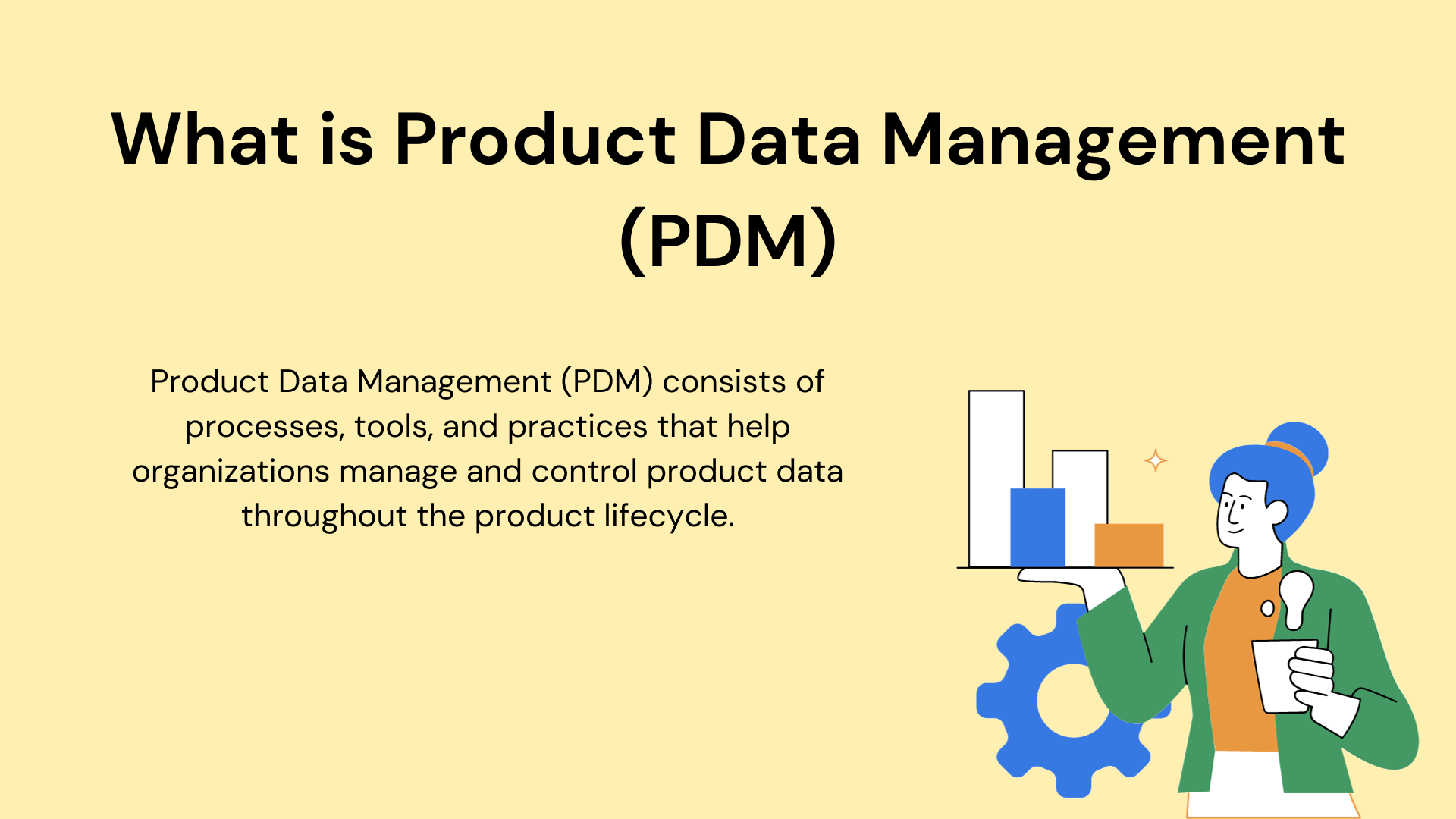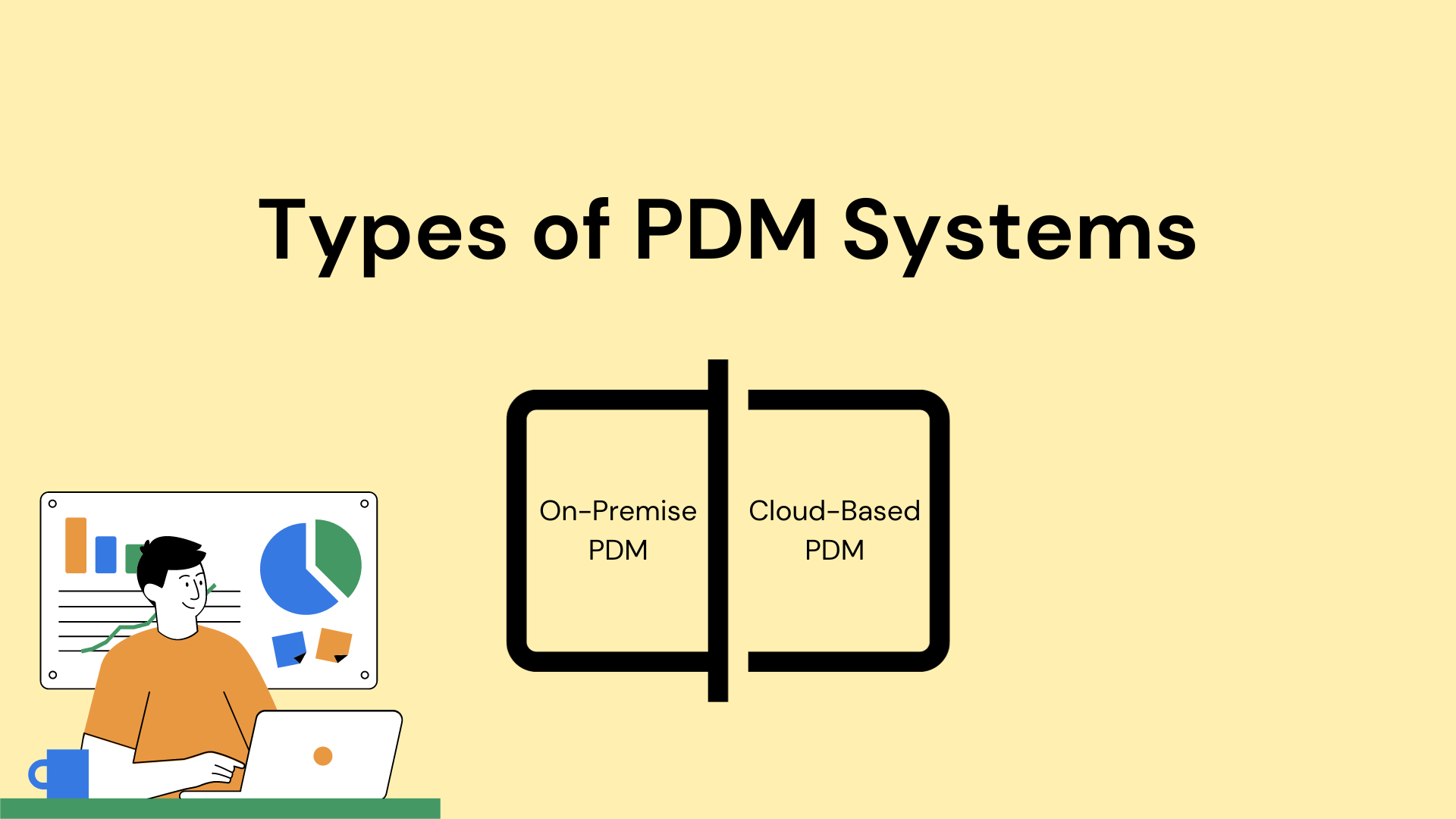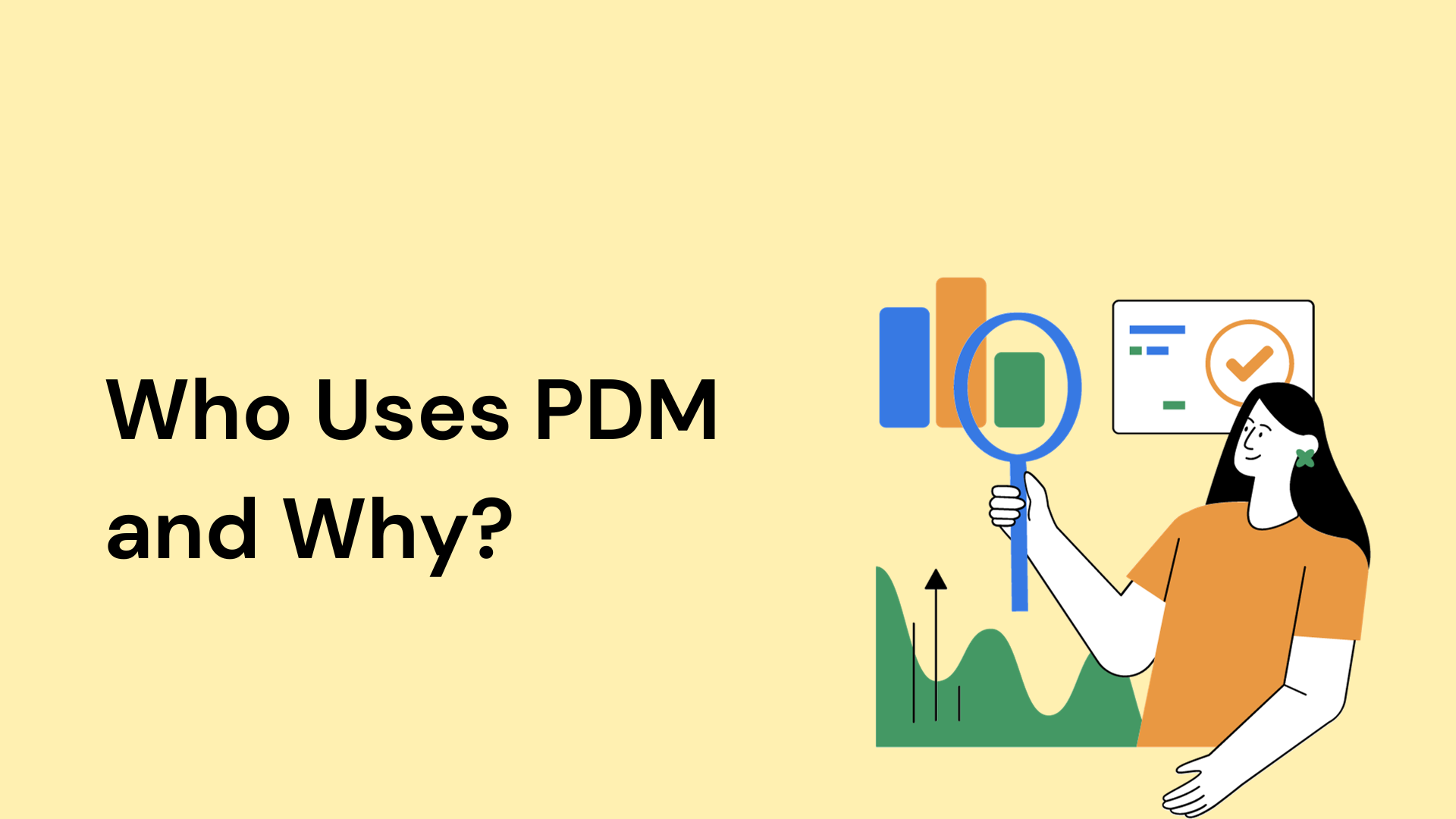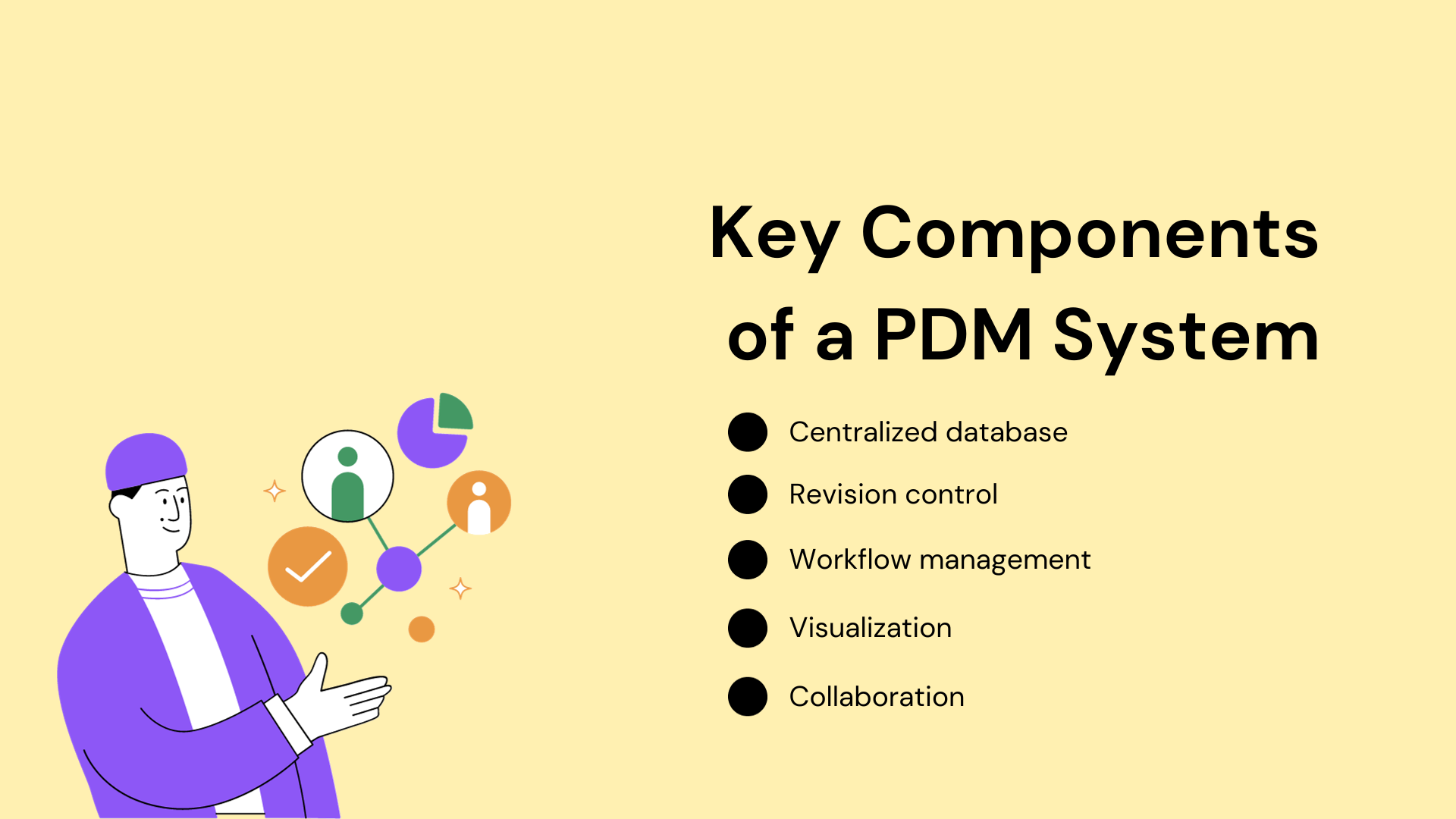Table of Contents:
- What Is Product Data Management (PDM)?
- Types of PDM Systems
- The Benefits of Using PDM
- How Does PDM Work?
- Who Uses PDM and Why?
- Key Components of a PDM System
- Choose the Right PDM Solution for Your Business
- Best Practices of PDM
Introduction
As a business leader, you know that managing the data associated with your products is critical to running an efficient operation.
Product data management solutions help companies gain control of this complex but crucial information to optimize key processes.
In this article, we will explore everything you need to know about product data management, including what it is, the benefits it offers, how the systems work, who uses these solutions, and the components that make up a product data management platform.
With an effective product data management strategy, you can improve product quality, shorten time to market, reduce costs, and boost customer satisfaction.
Read on to learn why product data management should be a high priority for your organization.
What Is Product Data Management (PDM)?

Product Data Management (PDM) is a tool used to manage and organize product data and related documents within an organization.
It allows companies to have a single source of truth for all information related to their products.
From product design to manufacturing and marketing, PDM takes care of every aspect of the product lifecycle.
It aids in streamlining the product development process, ensuring data accuracy, and providing a centralized platform for collaboration among different teams.
Types of PDM Systems

There are two primary categories of PDM systems. Each has unique advantages and disadvantages depending on the organization's size, resources, and requirements.
Here are the characteristics, pros, and cons of both on-premise and cloud-based PDM solutions.
On-Premise PDM
An on-premise PDM system is installed and hosted on the organization's in-house servers. This type of PDM solution often grants you more control over the infrastructure and offers customized solutions tailored to your unique business needs.
Pros:
- Control Over Data Security: On-premise PDMs provide the organization with greater control over their data security measures. This can be especially important for companies that work with highly sensitive or protected information.
- Customization: An on-premise PDM system allows for more extensive customization to meet specific business requirements. From implementing unique workflows to integrating with proprietary software, on-premise solutions can be tailored to fit your organization's needs.
Cons:
- Higher Costs: The initial costs for setting up an on-premise PDM system can be substantial, taking into account the cost of server hardware, software licenses, and IT staff to manage the system. Additionally, ongoing maintenance and updates can add to the overall expense.
- Limited Accessibility: On-premise PDM systems usually only grant access to employees within the organization's network. This can lead to hurdles when attempting to share data with external stakeholders or collaborating with remote team members.
Cloud-Based PDM
A cloud-based PDM system is hosted on remote servers managed by a third-party provider. Cloud-based PDM solutions offer scalability, cost-effectiveness, and ease of access from any location.
Pros:
- Lower Upfront Costs: With cloud-based PDM, businesses can avoid investing in costly infrastructure and generally pay on a subscription basis. This can be particularly advantageous for small- to medium-sized businesses or startups.
- Easy Scalability: As your organization grows, a cloud-based PDM system can quickly and easily expand to accommodate increased workloads, users, and data storage needs.
Cons:
- Data Security Concerns: Although cloud-based PDM providers prioritize implementing robust security measures, organizations may still have concerns about the security of their data in the hands of third-party vendors.
- Potential Vendor Lock-in: Selecting a cloud-based PDM system might lead to dependence on the solution provider, making it difficult to switch systems or migrate data in the future.
The Benefits of Using PDM

Using a Product Data Management (PDM) system provides numerous benefits to businesses.
Streamlined Product Development
PDM software facilitates collaboration between teams during product design and development.
All product data, documents, and files are stored in a central repository that provides version control and user access controls.
This eliminates data silos, ensures everyone is working with the latest information, and streamlines communication and approvals.
Improved Product Quality
With PDM, complete product histories are retained, allowing for traceability of all changes.
Impact analysis can identify how a proposed engineering change might affect the rest of the product.
This results in higher-quality products that meet all requirements and pass compliance standards.
Cost and Time Savings
PDM automates many time-consuming tasks like data entry, document routing, and change management.
It provides a single source of truth for product data that prevents rework from outdated or incorrect information. This significantly reduces costs and accelerates time to market.
Better Decision Making
Comprehensive product data in one place gives managers and executives a clear, up-to-date view of product costs, schedules, and risks to support strategic decision-making.
Dashboards and reports can provide insights into key performance indicators and metrics across the entire product portfolio.
In summary, PDM software offers substantial benefits through increased productivity, reduced costs, improved quality, and data-driven decision-making.
For any company that designs, manufactures, or distributes complex products, a PDM system is essential for operational efficiency and competitive advantage.
How Does PDM Work?

Product data management (PDM) software allows companies to organize and control critical information about the products they design, manufacture, and sell.
PDM works by providing a secure central database to store all product data in one place. This includes technical specifications, design files, documents, part numbers, prices, and more.
PDM systems provide a central repository for all product data that can be accessed by stakeholders across an organization.
PDM software typically includes the following main components:
- A vault or database to store all product data in a centralized location. This includes engineering specifications, product documentation, marketing materials, and more.
- A check-in/check-out function to manage access to data files. This ensures multiple team members do not edit the same file simultaneously, which could lead to data corruption.
- Revision control tools to track changes made to data files over time. This creates an audit trail showing who made what changes and when. Previous file versions can also be restored if needed.
- Advanced search capabilities to quickly find specific data based on parameters like file name, type, date modified, and keywords. This makes it easy to locate data even in systems containing huge volumes of files.
- Permissions and access controls to restrict sensitive data to approved users and groups. This helps companies maintain data security and confidentiality.
- Automated workflows to move data through review and approval processes. This streamlines the process of validating and releasing new or updated product data.
Who Uses PDM and Why?

Product data management (PDM) systems are utilized by companies across many industries to efficiently manage critical product information.
Different teams like engineering, marketing, sales, and support all have access to the information they need within the PDM solution.
Design and engineering teams rely on PDM to collaborate on new product designs. They can use PDM to share CAD files, specifications, and other technical drawings to streamline the development process.
By centralizing all product data in one system, teams have a single source of truth to work from, reducing errors and wasted effort.
Manufacturing organizations implement PDM to properly manage bills of materials (BOMs), manufacturing instructions, and product structures.
PDM helps ensure that the correct components, parts, and assemblies are used during production. It also gives visibility into product data for supply chain partners, enabling more seamless collaboration.
Quality and compliance departments take advantage of PDM for managing product certifications, testing data, and compliance documentation.
With PDM, this critical information can be directly tied to specific product data for simplified reporting and auditing.
Marketing and sales teams also benefit from PDM. They can access a centralized repository of product images, descriptions, specifications, and other attributes to create targeted marketing campaigns and sales collateral.
Key Components of a PDM System

A product data management (PDM) system is essential for any company that designs, develops or manufactures products. The key components of a PDM system include:
Centralized database
A PDM system stores all product-related data and documents in a centralized database. This makes it easy to organize, access and share data across the organization.
The database typically contains 3D models, 2D drawings, product requirements, bills of materials (BOMs), change requests, and more.
Revision control
As products evolve through design changes and modifications, a PDM system tracks and manages different versions of the data.
It maintains the revision history of each document and model, allowing users to access any previous version. Strict access controls also ensure that only authorized users can make changes.
Workflow management
PDM systems provide tools to define, monitor, and, optimize product development processes.
They can automate review and approval workflows, notify team members when action is required, and keep projects on schedule.
This helps improve productivity and consistency across the new product introduction process.
Visualization
Advanced PDM systems offer 3D visualization capabilities to view product models, assemblies, and drawings. Users can rotate, zoom, and pan to inspect all aspects of the product.
Some systems also allow virtual reality and augmented reality experiences. Visualization provides an intuitive way to explore product data, identify issues early, and make better design decisions.
Collaboration
A PDM system facilitates collaboration across global cross-functional teams. It gives all authorized team members a single source of truth for the latest product information.
Built-in communication tools like discussions, messages, and notifications help keep teams aligned and connected. This results in higher quality products developed in less time.
Choose the Right PDM Solution for Your Business
Now that you’ve known the benefits, primary types, and key components of PDM systems, let's consider the best approach for selecting the right one for your organization:
Analyze Your Business Requirements
Understand your organization's needs, both short-term and long-term. Is your company rapidly growing, necessitating a scalable solution? Do you operate in an industry with strict security requirements? Consider these factors when comparing PDM types.
Evaluate Financial Implications
Calculate the costs associated with each type of PDM system, from initial setup to ongoing maintenance and upgrades. Determine which option is most budget-friendly for your organization.
Review Security Considerations
Depending on the nature of your product data, one type of PDM solution may offer a more appropriate level of security. Be sure to prioritize this factor when deciding on a system.
Assess Integration Capabilities
Each PDM solution may vary in its ability to integrate with other software tools used by your organization. Ensure you choose a system that is compatible and can streamline your overall workflow.
Following these steps will help you make an informed decision about the right PDM solution or software for your business.
Best Practices of PDM

The following recommended practices can improve your PDM efforts' effectiveness, resulting in smoother processes and improved products.
Involve All Relevant Stakeholders
It is essential that all relevant stakeholders be involved in PDM implementation and ongoing management.
This inclusivity ensures that all departments consider their unique needs and workflows and allows for better cross-departmental collaboration.
Establish Clear Workflows
Workflows define how data travels from one stage to another and who is responsible for each step.
Clear, documented workflows prevent data mismanagement and inefficiencies while ensuring smooth transitions between product lifecycle stages.
Emphasize Data Accuracy
Accurate, up-to-date information is a must for any successful PDM system. Implement processes to validate data accuracy, and train team members to understand the importance of entering and maintaining accurate data.
Ensure capacities for version control, so changes in design or manufacturing instructions are clearly tracked over time.
Integrate with Other Business Systems
PDM should not exist in a silo. The very nature of PDM, spanning across the entire product lifecycle, makes it a prime candidate for integration with other business systems like ERP (Enterprise Resource Planning), CRM (Customer Relationship Management), and PLM (Product Lifecycle Management).
Integration alleviates data inconsistencies and further streamlines operations.
Prioritize Security
The importance of data security in PDM cannot be overstated. Attend to all levels of security, including access permissions, data encryption, and data backup systems.
Regularly audit your PDM security measures to ensure they are up-to-date and continue to protect sensitive data.
Regularly Review and Improve
The world of product development is dynamic, and PDM needs to keep pace. Make it a habit to review your PDM system regularly to identify improvements or necessary changes, and maintain its efficiency and impact on your products.
Train Your Team
Proper training is the cornerstone of any successful PDM adoption. Ensure your team understands how to use the PDM system and is aware of its benefits and mechanisms.
Ongoing training is also beneficial to keep employees informed about updates, best practices, and tips for efficiency.
Conclusion
After reading this article, you should now have a solid understanding of what product data management is and why it's so critical for businesses today.
With increasing competition and customer expectations, ensuring high quality, and consistent product data across all channels is essential for success.
By implementing a product data management solution, you can gain control of your product information, improve operational efficiency, boost sales, and provide an exceptional customer experience.
The benefits of product data management are clear. For any company dealing with large amounts of product data, a PDM system has become a necessity, not a luxury.
The time to get started is now. Take the first step and evaluate how product data management can transform your business.







